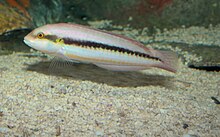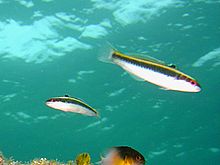Halichoeres
| Halichoeres | ||||||||||||
|---|---|---|---|---|---|---|---|---|---|---|---|---|

Checkerboard Junker ( Halichoeres hortulanus ) |
||||||||||||
| Systematics | ||||||||||||
|
||||||||||||
| Scientific name | ||||||||||||
| Halichoeres | ||||||||||||
| Rüppell , 1835 |
Halichoeres is a species-rich and very diverse genus of Junker wrasse (Julidinae). There are over 70 species, 20 of which are distributed in the eastern Pacific and Atlantic , the rest in the tropical areas of the Indo-Pacific .
features
Halichoeres species become 10 to 25 centimeters long. They have an elongated, laterally flattened body that is covered by large cycloid scales. They are smaller on the neck and chest, and the head is mostly scaly. In some species there are small scales on the gill covers. The mouth is terminal , pointed and small, the teeth are conical and decrease in size from front to back. Some species have enlarged canines in their upper jaws, it may be that these are only males. The lateral line organ makes a kink behind the dorsal fin.
The colors of the Halichoeres species differ depending on the habitat. Species from flat zones have colors and markings that camouflage them between algae, species living in deeper regions are usually more vividly colored. The coloring of juvenile fish, females and males is mostly different. Young fish often have multiple eye spots .
Way of life
Halichoeres species mostly live near coral reefs , always near sandy bottoms. However, they also inhabit seagrass meadows, rock reefs overgrown with sponges or algae, estuaries and ports. They feed on small invertebrates such as crabs and worms. Larger species of small fish too. The food is mostly sought on the ground. Species that live in schools also go far into the open water to eat zooplankton . At night the fish bury themselves in the sandy bottom.
Systematics
Halichoeres is (was) the largest genus of wrasse. 150 years ago the ichthyologist Pieter Bleeker suggested dividing them into different genres. The Australian underwater photographer and author Rudie Kuiter divides them into subgenus in his monograph on Junker and pygmy wrasse, and in his comprehensive "Atlas of Marine Fish" he finally divides the genus without providing a description of the new genus.
In a phylogenetic study, the genus is divided into three large clades : the New World clade contains species from the western Atlantic and the eastern Pacific and corresponds to Kuiter's new genus Iridio , a small Indo-Pacific clade corresponds to Kuiter's new genus Hemitautoga and contains three large species. Iridio and Hemitautoga are sister groups and together the sister group of a clade from Coris , Hologymnosus and other genera. The other Halichoeres species form a large Indo-Pacific clade to which the genus Macropharyngodon also belongs.

- large Indo-Pacific clade
- actual Halichoeres species, subgenus Halichoeres
- Pearl Junker ( Halichoeres bicolor ) (Bloch & Schneider, 1801)
- Halichoeres gurrobyi Victor, 2016
- Hartzfeld's Junker ( Halichoeres hartzfeldii ) (Bleeker, 1852)
- Peliciers Junker ( Halichoeres pelicieri ) (Randall & Smith, 1982)
- Sri Lankan Junker ( Halichoeres zeylonicus ) (Bennett, 1833)
- Genus Biochoeres
- Halichoeres biocellatus (Schultz, 1960)
- Halichoeres claudia Randall & Rocha [LA] 2009
- Lemon Junker ( Halichoeres chrysus ) (Randall, 1981)
- Halichoeres cosmetus (Randall & Smith, 1982)
- Yellow-headed Junker ( Halichoeres iridis ) (Randall & Smith, 1982)
- Canary Junker ( Halichoeres leucoxanthus ) (Randall & Smith, 1982)
- Halichoeres melasmapomus (Randall, 1981)
- Halichoeres orientalis (Randall, 1999)
- Halichoeres ornatissimus (Garrett, 1863)
- Pink Junker ( Halichoeres pallidus ) ( Kuiter & Randall, 1995)
- Pale Junker ( Halichoeres trispilus ) (Randall & Smith, 1982)
- Genus Corichoeres
- Halichoeres melanochir (Fowler & Bean, 1928)
- Gray-headed Junker ( Halichoeres prosopeion ) (Bleeker, 1853)
- Halichoeres signifer (Randall & Earle, 1994)
- Solor Junker ( Halichoeres solorensis ) (Bleeker, 1853)
- Halichoeres tenuispinis (Günther, 1862)
- Genus Hemiulis
- Seagrass Junker ( Halichoeres argus ) (Bloch & Schneider, 1801)
- Saowisata Junker ( Halichoeres binotopsis ) ( Bleeker , 1849)
- Brownfields Junker ( Halichoeres brownfieldi ) (Whitley, 1945)
- Grünkopf-Junker ( Halichoeres chlorocephalus ) (Kuiter & Randall, 1995)
- Red-nosed Junker ( Halichoeres kallochroma ) (Bleeker, 1853)
- Blue-headed Junker ( Halichoeres leucurus ) (Walbaum, 1792)
- Halichoeres marginatus (Rüppell, 1835)
- Hoebens Junker ( Halichoeres melanurus ) (Bleeker, 1851)
- Weißfleck-Junker ( Halichoeres nigrescens ) (Bloch & Schneider, 1801)
- Halichoeres papilionaceus ( Valenciennes , 1839)
- Richmonds Junker ( Halichoeres richmondi ) (Fowler & Bean, 1928)
- Red-headed Junker ( Halichoeres rubricephalus ) (Kuiter & Randall, 1995)
- Timor Junker ( Halichoeres timorensis ) (Bleeker, 1852)
- Genus Hemichoris
- Green Junker ( Halichoeres chloropterus ) (Bloch, 1791)
- White-throated Junker ( Halichoeres podostigma ) (Bleeker, 1854)
- Genus Octocyodon
- Halichoeres margaritaceus (Valenciennes, 1839)
- Halichoeres miniatus (Valenciennes, 1839)
- Halichoeres nebulosus (Valenciennes, 1839)
- actual Halichoeres species, subgenus Halichoeres
- small Indo-Pacific clade, subgenus Hemitautoga , genus Hemitautoga
- Checkerboard Junker ( Halichoeres hortulanus ) ( Lacépède , 1801)
- Zigzag Junker ( Halichoeres scapularis ) (Bennett, 1832)
- Dreifleck-Junker ( Halichoeres trimaculatus ) (Quoy & Gaimard, 1834)
- New world clade, genus Iridio
- Halichoeres adustus (Gilbert, 1890)
- Halichoeres bathyphilus (Beebe & Tee-Van, 1932)
- Halichoeres bivittatus (Bloch, 1791)
- Halichoeres brasiliensis (Bloch, 1791)
- Halichoeres caudalis (Poey, 1860)
- Halichoeres chierchiae (Di Caporiacco, 1948)
- Halichoeres cyanocephalus (Bloch, 1791)
- Halichoeres dimidiatus (Agassiz, 1831)
- Halichoeres dispilus (Günther, 1864)
- Halichoeres discolor (Bussing, 1983)
- Halichoeres garnoti (Valenciennes, 1839)
- Halichoeres insularis (Allen & Robertson, 1992)
- Halichoeres malpelo (Allen & Robertson, 1992)
- Halichoeres melanotis (Gilbert, 1890)
- Halichoeres nicholsi (Jordan & Gilbert, 1882)
- Halichoeres notospilus (Günther, 1864)
- Halichoeres penrosei (Starks, 1913)
- Halichoeres pictus (Poey, 1860)
- Halichoeres poeyi (Steindachner, 1867)
- Halichoeres radiatus ( Linnaeus , 1758)
- Halichoeres salmofasciatus (Allen & Robertson, 2002)
- Halichoeres semicinctus (Ayres, 1859)
- Halichoeres socialis (Randall & Lobel, 2003)
-
incertae sedis
- Halichoeres aestuaricola (Bussing, 1972)
- Halichoeres bleekeri (Steindachner & Döderlein, 1887)
- Halichoeres burekae (Weaver & Rocha, 2007)
- Halichoeres girardi (Bleeker, 1859)
- Halichoeres lapillus (Smith, 1947)
- Halichoeres leptotaenia (Randall & Earle, 1994)
- Halichoeres maculipinna (Müller & Troschel, 1848), sister group to Thalassoma
- Halichoeres melas (Randall & Earle, 1994)
- Halichoeres pardaleocephalus (Bleeker, 1849)
- Halichoeres purpurescens (Bloch & Schneider, 1801)
- Halichoeres raisneri (Baldwin & McCosker, 2001)
- Halichoeres stigmaticus (Randall & Smith, 1982)
- Halichoeres vrolikii (Bleeker, 1855)
literature
- Rudie H. Kuiter : Wrasse. Ulmer, Stuttgart 2002, ISBN 3-8001-3973-1 .
- Hans A. Baensch , Robert Patzner: Mergus Sea Water Atlas Volume 1 , Mergus-Verlag, Melle, 1997, ISBN 3-88244-110-0
- Ewald Lieske, Robert F. Myers: Coral fish of the world. Year, Hamburg 1994, ISBN 3-86132-112-2 .
Individual evidence
- ↑ a b c Rudie H. Kuiter: Wrasse. Ulmer, Stuttgart 2002, ISBN 3-8001-3973-1
- ↑ a b c d e f g h Rudie H. Kuiter, Helmut Debelius: Atlas of the sea fish. Kosmos, Stuttgart 2006, ISBN 3-440-09562-2
- ↑ a b c d e Paul H. Barber, David R. Bellwood: Biodiversity hotspots: evolutionary origins of biodiversity in wrasses (Halichoeres: Labridae) in the Indo-Pacific and new world tropics. In: Molecular Phylogenetics and Evolution. Vol. 35, No. 1, April 2005, pages 235-253 doi : 10.1016 / j.ympev.2004.10.004
Web links
- Halichoeres on Fishbase.org (English)








